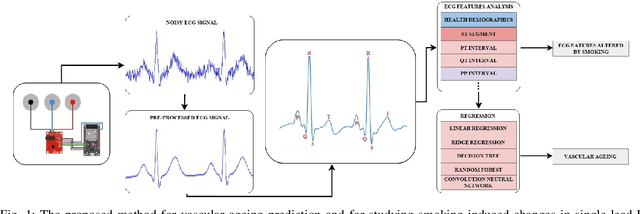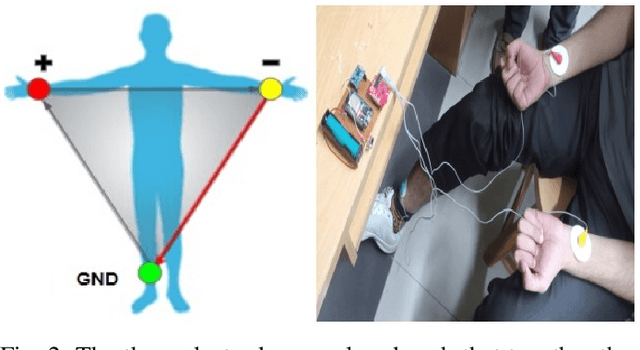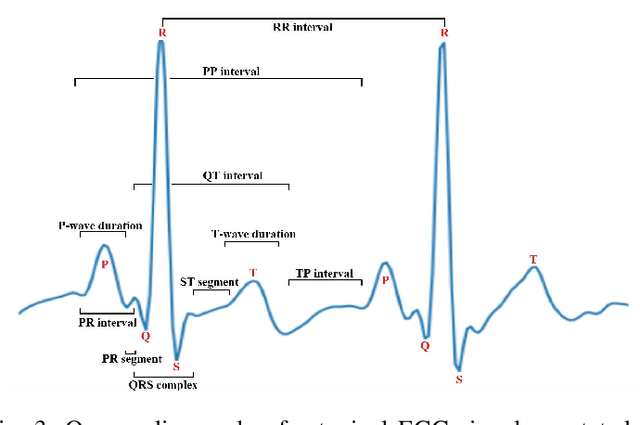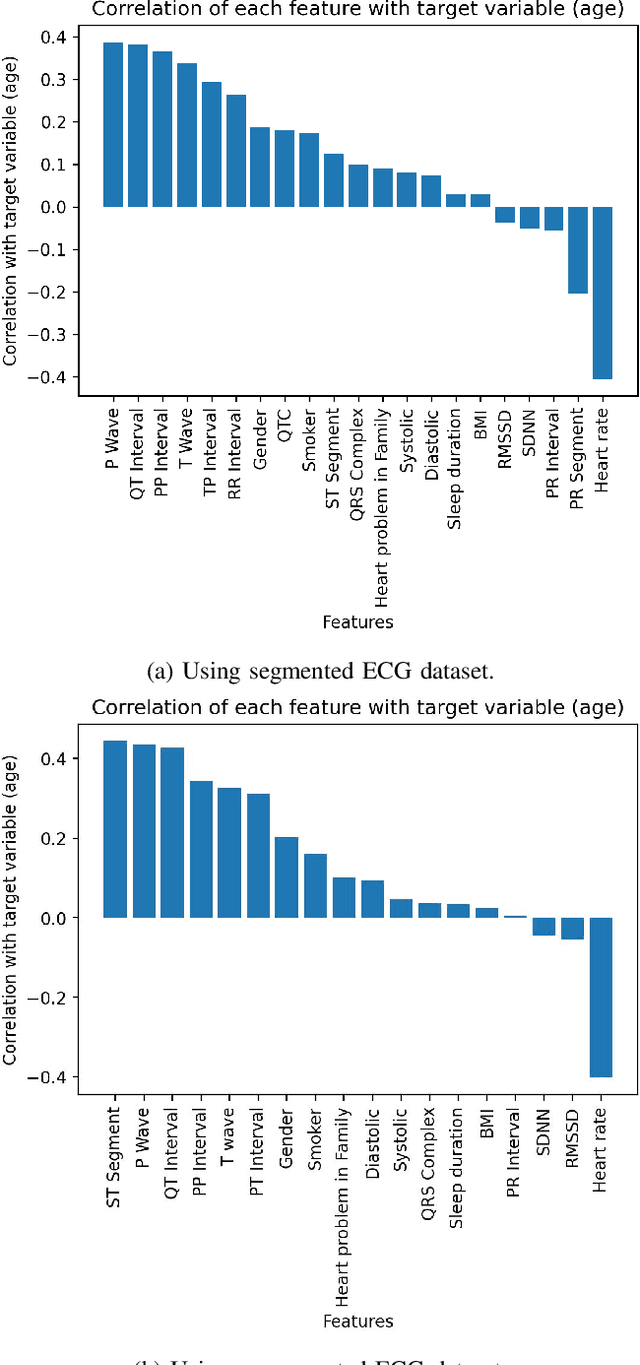Kashif Riaz
Cuff-less Arterial Blood Pressure Waveform Synthesis from Single-site PPG using Transformer & Frequency-domain Learning
Jan 09, 2024



Abstract:We propose two novel purpose-built deep learning (DL) models for synthesis of the arterial blood pressure (ABP) waveform in a cuff-less manner, using a single-site photoplethysmography (PPG) signal. We utilize the public UCI dataset on cuff-less blood pressure (CLBP) estimation to train and evaluate our DL models. Firstly, we implement a transformer model that incorporates positional encoding, multi-head attention, layer normalization, and dropout techniques, and synthesizes the ABP waveform with a mean absolute error (MAE) of 14. Secondly, we implement a frequency-domain (FD) learning approach where we first obtain the discrete cosine transform (DCT) coefficients of the PPG and ABP signals corresponding to two cardiac cycles, and then learn a linear/non-linear (L/NL) regression between them. We learn that the FD L/NL regression model outperforms the transformer model by achieving an MAE of 11.87 and 8.01, for diastolic blood pressure (DBP) and systolic blood pressure (SBP), respectively. Our FD L/NL regression model also fulfills the AAMI criterion of utilizing data from more than 85 subjects, and achieves grade B by the BHS criterion.
Vascular Ageing and Smoking Habit Prediction via a Low-Cost Single-Lead ECG Module
Aug 08, 2023



Abstract:This paper presents a novel low-cost method to predict: i) the vascular age of a healthy young person, ii) whether or not a person is a smoker, using only the lead-I of the electrocardiogram (ECG). We begin by collecting (lead-I) ECG data from 42 healthy subjects (male, female, smoker, non-smoker) aged 18 to 30 years, using our custom-built low-cost single-lead ECG module, and anthropometric data, e.g., body mass index, smoking status, blood pressure etc. Under our proposed method, we first pre-process our dataset by denoising the ECG traces, followed by baseline drift removal, followed by z-score normalization. Next, we divide ECG traces into overlapping segments of five-second duration, which leads to a 145-fold increase in the size of the dataset. We then feed our dataset to a number of machine learning models, a 1D convolutional neural network, a multi-layer perceptron (MLP), and ResNet18 transfer learning model. For vascular ageing prediction problem, Random Forest method outperforms all other methods with an R2 score of 0.99, and mean squared error of 0.07. For the binary classification problem that aims to differentiate between a smoker and a non-smoker, XGBoost method stands out with an accuracy of 96.5%. Finally, for the 4-class classification problem that aims to differentiate between male smoker, female smoker, male non-smoker, and female non-smoker, MLP method achieves the best accuracy of 97.5%. This work is aligned with the sustainable development goals of the United Nations which aim to provide low-cost but quality healthcare solutions to the unprivileged population.
Non-Contact Monitoring of Dehydration using RF Data Collected off the Chest and the Hand
Jun 16, 2023



Abstract:We report a novel non-contact method for dehydration monitoring. We utilize a transmit software defined radio (SDR) that impinges a wideband radio frequency (RF) signal (of frequency 5.23 GHz) onto either the chest or the hand of a subject who sits nearby. Further, another SDR in the closed vicinity collects the RF signals reflected off the chest (or passed through the hand) of the subject. Note that the two SDRs exchange orthogonal frequency division multiplexing (OFDM) signal, whose individual subcarriers get modulated once it reflects off (passes through) the chest (the hand) of the subject. This way, the signal collected by the receive SDR consists of channel frequency response (CFR) that captures the variation in the blood osmolality due to dehydration. The received raw CFR data is then passed through a handful of machine learning (ML) classifiers which once trained, output the classification result (i.e., whether a subject is hydrated or dehydrated). For the purpose of training our ML classifiers, we have constructed our custom HCDDM-RF-5 dataset by collecting data from 5 Muslim subjects (before and after sunset) who were fasting during the month of Ramadan. Specifically, we have implemented and tested the following ML classifiers (and their variants): K-nearest neighbour (KNN), support vector machine (SVM), decision tree (DT), ensemble classifier, and neural network classifier. Among all the classifiers, the neural network classifier acheived the best classification accuracy, i.e., an accuracy of 93.8% for the proposed CBDM method, and an accuracy of 96.15% for the proposed HBDM method. Compared to prior work where the reported accuracy is 97.83%, our proposed non-contact method is slightly inferior (as we report a maximum accuracy of 96.15%); nevertheless, the advantages of our non-contact dehydration method speak for themselves.
Myocardial Infarction Detection from ECG: A Gramian Angular Field-based 2D-CNN Approach
Feb 25, 2023Abstract:This paper presents a novel method for myocardial infarction (MI) detection using lead II of electrocardiogram (ECG). Under our proposed method, we first clean the noisy ECG signals using db4 wavelet, followed by an R-peak detection algorithm to segment the ECG signals into beats. We then translate the ECG timeseries dataset to an equivalent dataset of gray-scale images using Gramian Angular Summation Field (GASF) and Gramian Angular Difference Field (GADF) operations. Subsequently, the gray-scale images are fed into a custom two-dimensional convolutional neural network (2D-CNN) which efficiently differentiates the ECG beats of the healthy subjects from the ECG beats of the subjects with MI. We train and test the performance of our proposed method on a public dataset, namely, Physikalisch Technische Bundesanstalt (PTB) ECG dataset from Physionet. Our proposed approach achieves an average classification accuracy of 99.68\%, 99.80\%, 99.82\%, and 99.84\% under GASF dataset with noise and baseline wander, GADF dataset with noise and baseline wander, GASF dataset with noise and baseline wander removed, and GADF dataset with noise and baseline wander removed, respectively. Our proposed method is able to cope with additive noise and baseline wander, and does not require handcrafted features by a domain expert. Most importantly, this work opens the floor for innovation in wearable devices (e.g., smart watches, wrist bands etc.) to do accurate, real-time and early MI detection using a single-lead (lead II) ECG.
 Add to Chrome
Add to Chrome Add to Firefox
Add to Firefox Add to Edge
Add to Edge